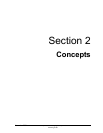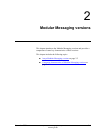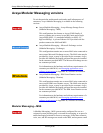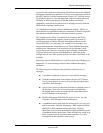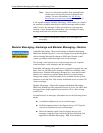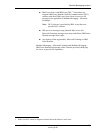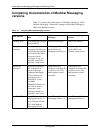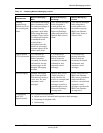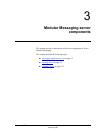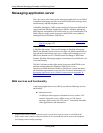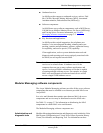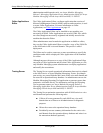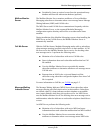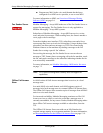
Modular Messaging versions
November 2004
Avaya Modular Messaging Concepts and
Planning Guide
2-7
Desktop
graphical user
interfaces (GUIs)
for accessing the
inbox
The Modular Messaging
inbox containing voice,
fax, and text messages is
separate from the
corporate e-mail inbox.
When using Microsoft
Outlook (Client Add-in
for Microsoft Outlook),
or standards-based
e-mail clients,
subscribers have the
benefit of accessing 2
separate inboxes in the
same e-mail client.
Voice and fax messages
in the subscriber’s
e-mail mailbox are
accessible using any
Microsoft Exchange
(Microsoft Outlook or
Outlook Web Access)
client.
Voice and fax messages
in the subscriber’s
e-mail mailbox are
accessible using any
IBM Lotus Domino
(IBM Lotus Notes or
iNotes) client.
Text-to-speech
(TTS) conversion
TTS required for
playing subscriber
names (when not
recorded), fax header
information, and any
text messages in the
Modular Messaging
mailbox.
TTS required for
playing subscriber
names (when not
recorded), fax header
information, and
corporate e-mail
messages.
TTS required for
playing subscriber
names (when not
recorded), fax header
information, and
corporate e-mail
messages.
Web messaging Modular Messaging
Web Client provides
Web-browser access to
voice, text, fax, and
corporate e-mail
messages.
Outlook Web Access
(OWA) provides a
single interface for
access to voicemail and
corporate e-mail
messages, stored in a
common inbox on the
Microsoft Exchange
message store.
iNotes, also known as
IBM Lotus Domino
Web Access, provides a
single interface for
access to voicemail and
corporate e-mail
messages, stored on the
IBM Lotus Domino
message store.
Compatibility
with UCC
Speech Access
UCC Speech Access provides:
! Speech access to voicemail and corporate e-mail messages
! Launching of telephone calls
! Conferencing
Table 2-1. Comparing Modular Messaging versions
Characteristic
Modular Messaging—
MSS
Modular Messaging—
Exchange
Modular Messaging—
Domino



